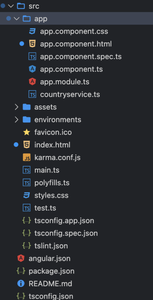Angular PrimeNG Form Chips模板组件
Angular PrimeNG是一个开源的框架,有丰富的原生Angular UI组件,用来做很好的造型,这个框架用来做响应式的网站,非常方便。这篇文章将告诉我们如何在Angular ngx bootstrap中使用日历组件。
Chips模板组件:它用于在一个带有图标的输入栏上输入多个值。
语法:
<p-chips [(ngModel)]="values3">
<ng-template let-item pTemplate="item">
{{item}} - (active) <i class="pi pi-user p-ml-2"></i>
</ng-template>
</p-chips>
创建Angular应用程序和模块安装。
第1步:使用以下命令创建一个Angular应用程序。
ng new appname
第2步:创建你的项目文件夹即appname后,使用以下命令移动到它。
cd appname
第3步:在你给定的目录中安装PrimeNG。
npm install primeng --save
npm install primeicons --save
Project Structure:

示例1:在下面的代码中,我们将使用上述语法来演示表格Chips模板组件的使用。
<div style="text-align:center;">
<h1 style="color:green;">GeeksforGeeks</h1>
<h3>A computer science portal for geeks</h3>
<h4>Angular PrimeNG Form Chips Template Component</h4>
<div class="p-fluid">
<h5>Template</h5>
<p-chips [(ngModel)]="values3">
<ng-template let-item pTemplate="item">
{{item}} - (active)
<i class="pi pi-user p-ml-2"></i>
</ng-template>
</p-chips>
</div>
</div>
import { Component } from '@angular/core';
import { MenuItem } from 'primeng/api';
@Component({
selector: 'app-root',
templateUrl: './app.component.html'
})
export class AppComponent {
values1: string[];
values2: string[];
values3: string[];
}
import { NgModule } from '@angular/core';
import { BrowserModule } from '@angular/platform-browser';
import { FormsModule } from '@angular/forms';
import { HttpClientModule } from '@angular/common/http';
import { BrowserAnimationsModule } from
'@angular/platform-browser/animations';
import { AppComponent } from './app.component';
import { ChipsModule } from 'primeng/chips';
import { ButtonModule } from 'primeng/button';
@NgModule({
imports: [
BrowserModule,
BrowserAnimationsModule,
ChipsModule,
ButtonModule,
FormsModule
],
declarations: [AppComponent],
bootstrap: [AppComponent]
})
export class AppModule { }
输出:

示例2:在下面的代码中,我们将使用上述语法来演示表格Chips模板组件的使用。
<div style="text-align:center;">
<h1 style="color:green;">GeeksforGeeks</h1>
<h3>A computer science portal for geeks</h3>
<h4>Angular PrimeNG Form Chips Template Component</h4>
<div class="p-fluid">
<h5>Template</h5>
<p-chips [(ngModel)]="values3">
<ng-template let-item pTemplate="item">
{{ item }} - (Offline)
<i class="pi pi-user p-ml-2"></i>
</ng-template>
</p-chips>
</div>
</div>
import { Component } from '@angular/core';
import { MenuItem } from 'primeng/api';
@Component({
selector: 'app-root',
templateUrl: './app.component.html'
})
export class AppComponent {
values1: string[];
values2: string[];
values3: string[];
}
import { NgModule } from '@angular/core';
import { BrowserModule } from '@angular/platform-browser';
import { FormsModule } from '@angular/forms';
import { HttpClientModule } from '@angular/common/http';
import { BrowserAnimationsModule } from
'@angular/platform-browser/animations';
import { AppComponent } from './app.component';
import { ChipsModule } from 'primeng/chips';
import { ButtonModule } from 'primeng/button';
@NgModule({
imports: [
BrowserModule,
BrowserAnimationsModule,
ChipsModule,
ButtonModule,
FormsModule
],
declarations: [AppComponent],
bootstrap: [AppComponent]
})
export class AppModule { }
输出:

 极客教程
极客教程